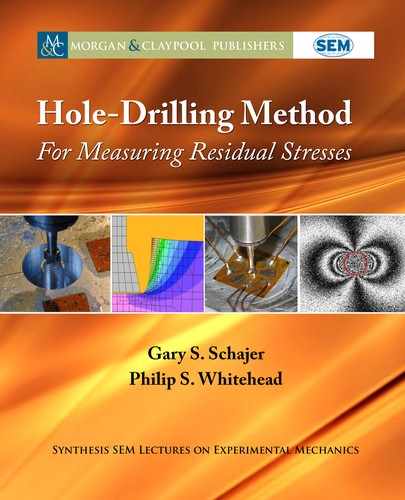148 7. OPTICAL TECHNIQUES
by the slight rotation of one of the beams or specimen to produce carrier fringes that super-
impose artificial tensile or compressive strains across the measured fringe patterns. Figure 7.4
illustrates some Moiré fringe patterns measured with superposed tensile and compressive carrier
fringes.
Both the Moiré and holographic techniques have the advantage of making useful mea-
surements very near to the hole boundary, much nearer than could be made by strain gauges.
When using an attached diffraction grating with the Moiré method, some minor delamination
of the grating near the hole edge can occur, which will limit the closeness of available measure-
ments. e surface preparation to attach or form the diffraction grating on the specimen surface
is a drawback of the Moiré method, but is not prohibitive.
7.4 ELECTRONIC SPECKLE PATTERN
INTERFEROMETRY (ESPI)
Electronic Speckle Pattern Interferometry (ESPI) is a popular interferometric measurement
technique that is widely used for surface metrology. It uses a video camera to record interfer-
ence pattern images. It is an attractive measurement approach because it avoids the need with
holographic interferometry for a thermoplastic plate or similar recording device.
Figure 7.5 shows a typical ESPI arrangement. e light from a coherent laser source is
divided into two beams, one of which illuminates the specimen surface and is subsequently
imaged by a digital camera, while the second feeds directly to the camera where it creates an
interference pattern on the sensor surface. e interference pattern, such as shown in Figure 7.6a,
appears as random speckles spread across the measured image. At first glance the interference
pattern appears as if it contains just noise. is is partly true inasmuch as there is a random phase
variation from one pixel to the next. However, each pixel considered alone behaves systematically
and has a phase that corresponds to the local phase difference between the illumination/object
and reference beams. Surface deformations created by hole-drilling cause small changes in the
optical path length of the illumination/object beam in Figure 7.5. ese path length changes in
turn cause proportional phase changes between the illumination/object beam and the reference
beams, which then manifest as corresponding phase changes at the measured image pixels.
e phase changes at the measured image pixels are typically evaluated using the phase
stepping method. A piezo actuator steps the reference beam by known phase angle steps, after
each of which a speckle image is measured. Most commonly, four images are taken at 90
ı
inter-
vals. ese measurements are made both before and after hole-drilling, producing a combined
set of images from which the phase change and hence the surface deformation at each pixel
can be evaluated mathematically. e example fringe pattern shown in Figure 7.6b graphically
represents the phase evaluated at each point. ese results define the phase within the cyclic
range < and are called “wrapped.” A further process called “unwrapping” is required
to arrange the phase data in continuous format so that they then properly represent the surface
displacements.

7.4. ELECTRONIC SPECKLE PATTERN INTERFEROMETRY (ESPI) 149
Object
Laser
Object Beam
Camera
Computer
Illumination Beam
Reference
Beam
?
??
??
Figure 7.5: Schematic diagram of a typical ESPI apparatus used for hole-drilling measurements
(adapted from Steinzig and Ponslet (2003)).
(a) (b)
Figure 7.6: ESPI hole-drilling measurements. (a) Speckle image and (b) fringe image.
e phase-stepping technique is particularly attractive because it produces a numerical
value of the surface deformation at each pixel location, including sign. is is big advantage
over the analog unsigned data from photographic holography and allows much more detailed
and sophisticated data analysis. e phase-stepping technique can also be used with the Moiré
method illustrated in Figure 7.3 and provides similar advantages.
..................Content has been hidden....................
You can't read the all page of ebook, please click here login for view all page.
